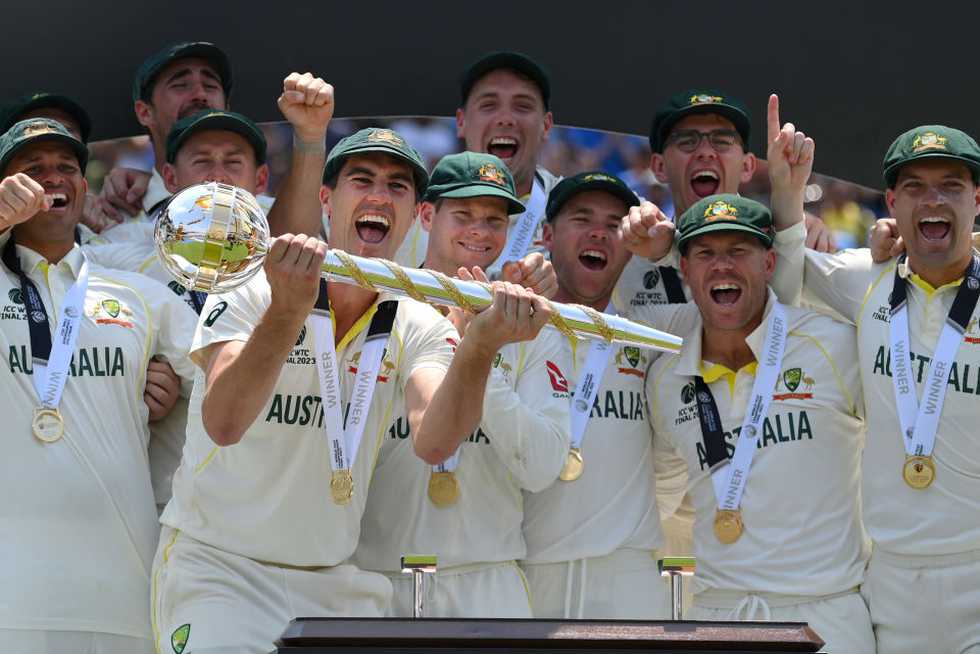
How Scott Boland and Travis Head spotlight the Pat Cummins era

It just had to be Scott Boland. You just knew it would be Scott Boland. It always is Scott Boland. That's been the constant narrative after all for a major part of the last 18 months for Australia as they marched towards the World Test Championship Final. A Scott Boland spell that sets the tone for the match. A Scott Boland spell that changes the course of a match. A Scott Boland spell that wins Australia the match.
And so it was on the crucial fifth morning of the World Test Championship Final at The Oval. If you ever wanted to see a masterclass on how to set up a world-class batter, this was it. Virat Kohli had looked impregnable while batting the previous evening. He'd then walked out to bat with the same intensity and assuredness while looking in ominous touch with India holding hopes of a miraculous run-chase. In Kohli they believed. But all Boland needed were 12 deliveries at the premier batter, to bring them back to reality.
He then added Ravindra Jadeja's wicket to his impressive set two deliveries later. The raucous Indian fans had been silenced. The fever-pitch energy around The Oval had dissipated. The hopes of India doing the unthinkable had been zapped. The contest was over for all practical purposes.
If it was Boland who set the stage for Australia's eventual march towards the World Test Championship mace on the final day, it was Travis Head who'd set the tone for it on the opening day. In conditions that seemed largely in favour of the fast bowlers, and with Australia's innings in a bit of a tizzy at 3/76, he'd produced one of the best-ever counterattacking centuries in the history of big world championship finals across formats. And it is Australia's comprehensively massive victory margin of 209 runs that really puts Head's belligerent 174-ball 163 into context, as to how it was the big difference between the two sides from a batting perspective.
In many ways, it just felt right that Australia's famous victory in south London was bookended by two outstanding performances from Head and Boland. And that they were the most significant performers with bat and ball. For, their respective journeys over the last year-and-a-half, or through this WTC cycle, have been a fascinating subplot to the overall narrative of the coronation of the Pat Cummins era, starring an ensemble cast of mega stars.
You just have to rewind the clock back to November 2021 when Australia set off on their own journey into the unknown under captain Cummins, appointed to the role in inopportune circumstances.

Head was the insider who seemed to be on his way out. Boland was the outsider who nobody ever thought would find a way in. But while Boland became the sensation who just kept taking wickets every time his captain threw the ball at him, Head was the man putting his hand up every time his team had their backs to the wall and the pitch was proving a challenge to bat on. Whether it was in Hobart against England, the Gabba against South Africa, the dramatic third morning in Indore against India or here at The Oval. No surprises then that Cummins would call them his two favourite players in his team. And two players you can't see him do without in a playing XI from this point on, which brings us to what Boland did to get rid of Kohli on Sunday (June 11) morning.
Having sized up Kohli's intention to get forward, both in terms of his feet and his body weight, to every delivery, Boland had cleverly begun to make the former India captain second-guess himself with subtle changes in line and length. He struck his pads with only his third delivery, the first time a ball had gone past Kohli's bat in the innings. He then got a delivery in his next over to shape back in off a length and nearly shave the right-hander's off-stump. He'd then started the next over by getting a delivery off a similar line and length to wobble away from Kohli, beating his bat in the process. Then came the wider sucker ball, dragging the master batter out, and getting him to edge to a diving Steve Smith at second slip. It's a sequence of deliveries you could watch on loop. The delivery to Jadeja in some ways was even better, as it angled into the left-hander from around the wicket and left him at exactly the point he was committed to play at it, grabbing the outside-edge as a result. It was then left for Nathan Lyon to have the final say, like he has on so many major victories for Australia in recent times.
And the script would be incomplete without two other remarkable comeback runs for two relatively more senior figures in Australian cricket. While Nathan Lyon started the Ashes at home 18 months ago on the back of a forgettable summer against the Indians, Usman Khawaja's Test career seemed to be hanging on a thread. That they should be the duo who played the most significant roles with ball and bat respectively in Australia's run to the WTC final is a wonderful story-line that ran parallel to the success that Cummins' team has achieved in this period.
The fact that they've also had several newer heroes emerging along the way only adds to the atmosphere that Cummins and head coach Andrew McDonald seemed to have built around the Australian dressing-room. There's the emergence of Cameron Green, the improvement of Alex Carey, the rise of Marnus Labuschagne, the return of Smith to his glorious best and the likes of Todd Murphy, Michael Neser and Matthew Kuhnemann who've all had impactful walk-on parts at different times.
That Australia would bowl out India within 70 overs in both innings without a single bowler grabbing a major chunk of the spoils was also in keeping with how well the fast bowlers in particular have complemented each other since Cummins took over. While Lyon finished with 5 five-wicket hauls during the WTC cycle, there were only 5 five-wicket hauls between the fast bowlers- three for Cummins and one each for Boland and Green - in 20 Tests that Australia played between December 2021 and the big final in London. For the record, there were 6 four-wicket hauls and 18 three-wicket hauls illustrating further just how united a front they were as a bowling unit, sharing the wickets around.
And overseeing it all was captain Cummins, the unassuming yet powerful star of the show. Under him, Australia found a different expression both on and off the field. And under him, they began closing out games both home and away after a period where they struggled to do so. Final-day panic and last-minute desperation were replaced with calculated confidence and belief in plans. It brought them victories in faraway climes like Lahore and Galle. It allowed them to dominate at home. And as Cummins and his team returned to the field of play at The Oval hours after they'd won their maiden WTC title, for a rendition of the team song while holding the WTC mace aloft, it felt more like a momentous event of a great chapter in Australian cricket, than its culmination. The crowning moment for the Pat Cummins era. And not for the first time, it all started with Scott Boland.
| Share | Tweet |





